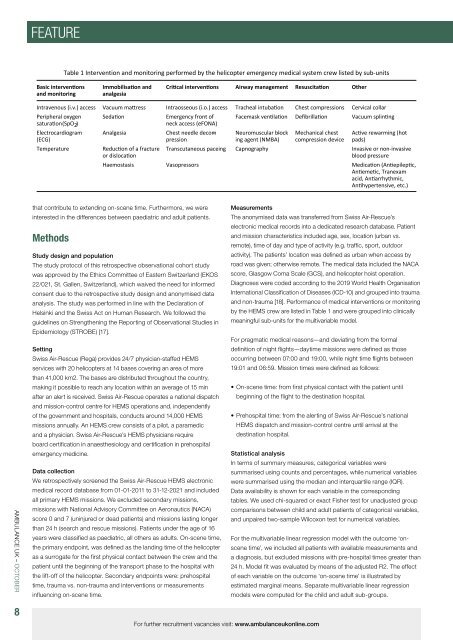Ambulance UK October 2023
Ambulance UK October 2023
Ambulance UK October 2023
You also want an ePaper? Increase the reach of your titles
YUMPU automatically turns print PDFs into web optimized ePapers that Google loves.
FEATURE<br />
Table 1 Intervention and monitoring performed by the helicopter emergency medical system crew listed by sub-units<br />
Basic interventions<br />
and monitoring<br />
Immobilisation and<br />
analgesia<br />
Critical interventions Airway management Resuscitation Other<br />
Intravenous (i.v.) access Vacuum mattress Intraosseous (i.o.) access Tracheal intubation Chest compressions Cervical collar<br />
Peripheral oxygen Sedation Emergency front of<br />
saturation (SpO2 ) neck access (eFONA)<br />
Electrocardiogram<br />
(ECG)<br />
Temperature<br />
Analgesia<br />
Reduction of a fracture<br />
or dislocation<br />
Chest needle decompression<br />
Facemask ventilation Defibrillation Vacuum splinting<br />
Neuromuscular block -<br />
ing agent (NMBA)<br />
Mechanical chest<br />
compression device<br />
Active rewarming (hot<br />
pads)<br />
Transcutaneous paceing Capnography Invasive or non-invasive<br />
blood pressure<br />
Haemostasis Vasopressors Medication (Antiepileptic,<br />
Antiemetic, Tranexam<br />
acid, Antiarrhythmic,<br />
Antihypertensive, etc.)<br />
AMBULANCE <strong>UK</strong> – OCTOBER<br />
that contribute to extending on-scene time. Furthermore, we were<br />
interested in the differences between paediatric and adult patients.<br />
Methods<br />
Study design and population<br />
The study protocol of this retrospective observational cohort study<br />
was approved by the Ethics Committee of Eastern Switzerland (EKOS<br />
22/021, St. Gallen, Switzerland), which waived the need for informed<br />
consent due to the retrospective study design and anonymised data<br />
analysis. The study was performed in line with the Declaration of<br />
Helsinki and the Swiss Act on Human Research. We followed the<br />
guidelines on Strengthening the Reporting of Observational Studies in<br />
Epidemiology (STROBE) [17].<br />
Setting<br />
Swiss Air-Rescue (Rega) provides 24/7 physician-staffed HEMS<br />
services with 20 helicopters at 14 bases covering an area of more<br />
than 41,000 km2. The bases are distributed throughout the country,<br />
making it possible to reach any location within an average of 15 min<br />
after an alert is received. Swiss Air-Rescue operates a national dispatch<br />
and mission-control centre for HEMS operations and, independently<br />
of the government and hospitals, conducts around 14,000 HEMS<br />
missions annually. An HEMS crew consists of a pilot, a paramedic<br />
and a physician. Swiss Air-Rescue’s HEMS physicians require<br />
board certification in anaesthesiology and certification in prehospital<br />
emergency medicine.<br />
Data collection<br />
We retrospectively screened the Swiss Air-Rescue HEMS electronic<br />
medical record database from 01-01-2011 to 31-12-2021 and included<br />
all primary HEMS missions. We excluded secondary missions,<br />
missions with National Advisory Committee on Aeronautics (NACA)<br />
score 0 and 7 (uninjured or dead patients) and missions lasting longer<br />
than 24 h (search and rescue missions). Patients under the age of 16<br />
years were classified as paediatric, all others as adults. On-scene time,<br />
the primary endpoint, was defined as the landing time of the helicopter<br />
as a surrogate for the first physical contact between the crew and the<br />
patient until the beginning of the transport phase to the hospital with<br />
the lift-off of the helicopter. Secondary endpoints were: prehospital<br />
time, trauma vs. non-trauma and interventions or measurements<br />
influencing on-scene time.<br />
Measurements<br />
The anonymised data was transferred from Swiss Air-Rescue’s<br />
electronic medical records into a dedicated research database. Patient<br />
and mission characteristics included age, sex, location (urban vs.<br />
remote), time of day and type of activity (e.g. traffic, sport, outdoor<br />
activity). The patients’ location was defined as urban when access by<br />
road was given; otherwise remote. The medical data included the NACA<br />
score, Glasgow Coma Scale (GCS), and helicopter hoist operation.<br />
Diagnoses were coded according to the 2019 World Health Organisation<br />
International Classification of Diseases (ICD-10) and grouped into trauma<br />
and non-trauma [18]. Performance of medical interventions or monitoring<br />
by the HEMS crew are listed in Table 1 and were grouped into clinically<br />
meaningful sub-units for the multivariable model.<br />
For pragmatic medical reasons—and deviating from the formal<br />
definition of night flights—daytime missions were defined as those<br />
occurring between 07:00 and 19:00, while night time flights between<br />
19:01 and 06:59. Mission times were defined as follows:<br />
• On-scene time: from first physical contact with the patient until<br />
beginning of the flight to the destination hospital.<br />
• Prehospital time: from the alerting of Swiss Air-Rescue’s national<br />
HEMS dispatch and mission-control centre until arrival at the<br />
destination hospital.<br />
Statistical analysis<br />
In terms of summary measures, categorical variables were<br />
summarised using counts and percentages, while numerical variables<br />
were summarised using the median and interquartile range (IQR).<br />
Data availability is shown for each variable in the corresponding<br />
tables. We used chi-squared or exact Fisher test for unadjusted group<br />
comparisons between child and adult patients of categorical variables,<br />
and unpaired two-sample Wilcoxon test for numerical variables.<br />
For the multivariable linear regression model with the outcome ‘onscene<br />
time’, we included all patients with available measurements and<br />
a diagnosis, but excluded missions with pre-hospital times greater than<br />
24 h. Model fit was evaluated by means of the adjusted R2. The effect<br />
of each variable on the outcome ‘on-scene time’ is illustrated by<br />
estimated marginal means. Separate multivariable linear regression<br />
models were computed for the child and adult sub-groups.<br />
8<br />
For further recruitment vacancies visit: www.ambulanceukonline.com
















